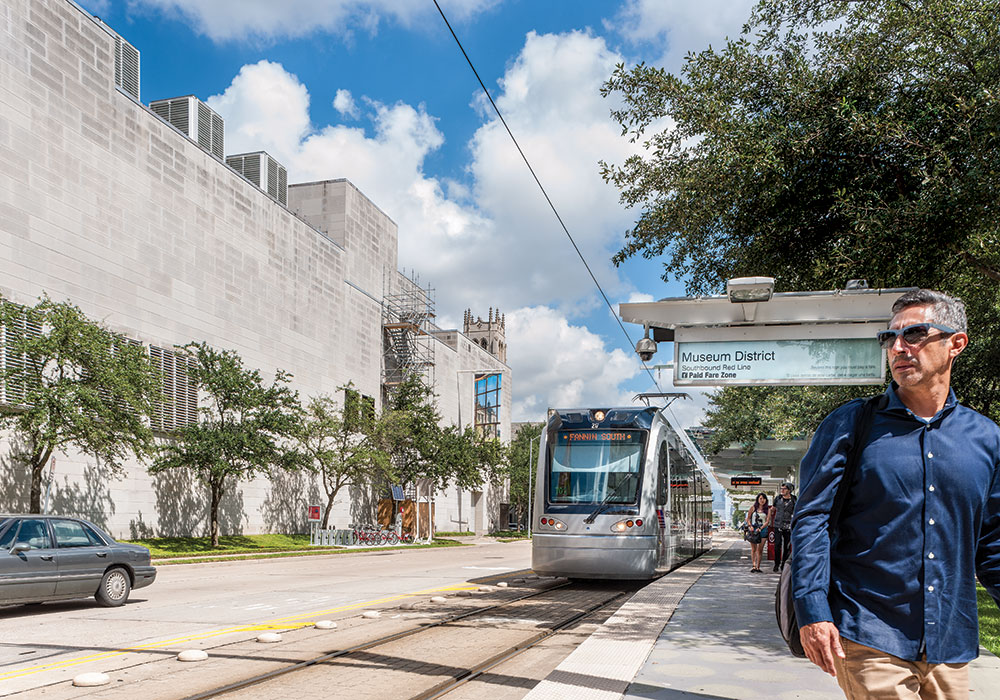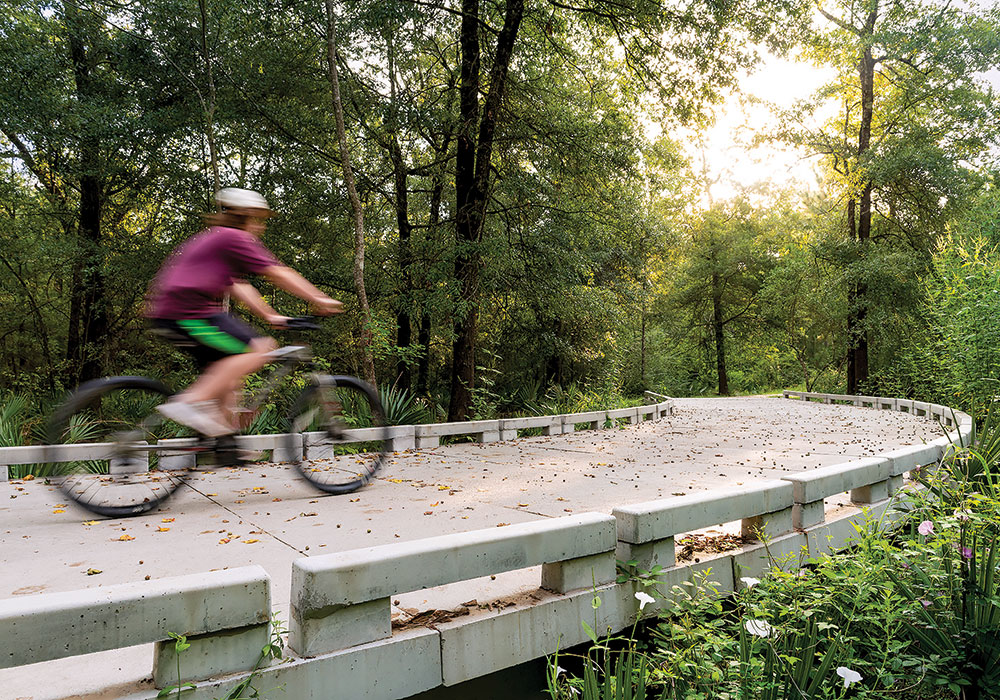Planning January 2020
Toward Modern Mobility
Formerly car-centric Houston is shifting in a multimodal direction.
By Leah Binkovitz
Shortly after he took office in 2016, Houston Mayor Sylvester Turner stood before a crowd of elected officials, media, and others at the city's inaugural State of Mobility speech and called for a paradigm shift in planning for Houston's mobility. "We will always have roadway capacity in this state," Turner said, "that will not change. But we should not limit ourselves just to roadway capacity."
Though Houston has earned its reputation as a car-centric metropolis, when Turner took the stage that day, the city had already garnered national attention for boosting ridership with a recent bus route overhaul that focused on improving frequency, and had recently approved its first-ever general plan, Plan Houston, which called for a multimodal transportation system for the region.
In the nearly four years since his speech, the city has made significant strides toward that vision: It approved the Houston Bike Plan in 2017, added 50 miles of bike lanes and trails across the city in coordination with the county, focused on safety improvements at some of the city's most dangerous intersections for pedestrians and bicyclists, expanded its redevelopment of the bayous into bikeable, walkable infrastructure, and more.
Amid a flurry of planning that seeks to address everything from resilience to encouraging transit and walkable development — helped along by a $3.5 billion transit bond approved in November — the city is in the middle of a massive, years-long state highway project. The North Houston Highway Improvement Project earned a spot on the U.S. Public Interest Research Group's latest list of highway boondoggles. It also has galvanized one of the most involved public engagement processes for a Texas transportation project in the state's history.
"We're talking about a new transportation [dynamic] that involves more [transit] options for more people while at the same time consistently increasing capacity for single-person vehicles," says Oni Blair, executive director of LINK Houston, a transit equity advocacy group. "If we want to make real progress toward a paradigm shift then we actually need to shift how we operate and make some hard choices about what we do as a city."


Houston is known for its Texas-sized highways, but it also wants to be recognized for multimodal efforts like pedestrian and bike infrastructure and light rail. Photos by Patrick Insull/Shutterstock and Paul Hester.
Shifting gears
Houston has always been an aspirational city, wrote Kyle Shelton, deputy director of the Kinder Institute for Urban Research, in his book Power Moves: Transportation, Politics, and Development in Houston. Its story has been one of growth, with ever-increasing loops of highways circling the city as municipal utility districts and master planned communities pushed the area's footprint farther and farther out from the city's swampy center at Allen's Landing.
But today, the challenges that come along with that growth are unavoidable. The Kinder Houston Area Survey has tracked the shifting attitudes of city residents for 38 years. In 2019, for the sixth year in a row, traffic topped the list of concerns. And the latest report from the Texas A&M Transportation Institute put Houston seventh nationally for congestion- caused delays, which cost an estimated $1,376 per commuter.
But traffic is just one part of the equation. There are also vehicle emissions and the city's carbon footprint. Houston ranked ninth in the country for carbon dioxide emissions, according to a 2018 study from the Norwegian University of Science and Technology. And many have blamed development and the spread of impermeable surfaces, in part, for worsened flooding.
At the same time, Houstonians' appetite for walkable urbanism and transit is growing. Parts of the city, including Gulfton and Montrose, already have levels of density to rival East Coast cities. And, according to the same Kinder Houston Area Survey, most residents would prefer to live in a walkable neighborhood. Even the suburban cities drawing people from the core have worked to create mixed-use developments that resemble downtowns, like the Sugar Land Town Center and the Town Center in The Woodlands.
But realizing this increasingly urban vision is proving tricky. State transportation funding is largely restricted to highway spending, the regional council of governments leans more toward suburban and rural counties than urban, and powerful opposition can still shape mass transit decisions.
Expanding transit
Fortunately for multimodal advocates, public transportation got a big boost at the ballot box this past November, when 68 percent of Houston voters approved METRO's $3.5 billion bond, the agency's first since 2003. In addition to its recently redesigned bus network, the city's transit system also includes three light rail lines that run through downtown and HOV lanes on the major highways in the area that carried some 26.5 million riders in the 2018 fiscal year.
The funds from the 2019 bond, which the agency hopes to match with federal and local dollars, will go toward one of its most ambitious efforts, the $7.5 billion METRONext Moving Forward Plan, which proposes 500 miles worth of improvements and expansions to the region's transportation system, including bus rapid transit, light rail, two-way HOV lanes with express bus service, and more.
"It goes far," says James Llamas, a principal at locally based Traffic Engineers, Inc., "and we're going to have to go far before we go farther." In particular, he says the proposed plan "does a great job building on our HOV express system, which is one of the most successful transit commuter systems in the country."
It remains to be seen how the city will prioritize the different projects included in the plan, but in its resolution calling for a bond vote, the transit agency noted that exact routes "will only be decided and finalized after an extensive community involvement process."
From the city's perspective, the public support for the ballot signals the desire for the changes the Houston planning department is hard at work on. "[It] dovetails perfectly with planning department initiatives such as Walkable Places, transit-oriented development rules, and the construction of more than 50 miles of high-comfort bike lanes," says planning director Margaret H. Wallace Brown, AICP, CNU-A. The city also recently lifted minimum parking requirements in two neighborhoods adjacent to downtown.
"This election demonstrates that Houstonians see clearly the need for improved transit options, including BRT, rail, and improved bus service, that provide safe and efficient transportation options for all Houstonians," says Wallace Brown.
Keeping Houston Moving
The METRONext plan that accompanies the $3.5 billion voter-approved bond aims to cover a lot of ground, helping to pay for:
110 miles of Regional Express Network, including two-way HOV lane
21 new or improved park & rides and transit centers
16 miles of light rail with a METRORail extension to Hobby Airport
75 miles of new METRORapid bus service that operate like light rail, including an extension to Bush Airport
290 miles of BOOST and Signature bus service, plus accessibility and usability improvements for the disabled and seniors
Source: METRONext Moving Forward Plan
Car-centric city, multimodal plans
However, a shift toward multimodal isn't just up to the city of Houston. The county government, the Harris County Toll Road Authority, the Harris County Flood Control District, the regional council of governments known as the Houston-Galveston Area Council, and state and federal transportation departments all play a role in Houston's transportation decisions. There are some signs of change, but it's unclear whether it's enough.
"There's a huge need for multimodal," says Charles Wemple, H-GAC's executive director. "We're having conversations about transit in particular more than we ever have before."
So far that's meant setting up a high-capacity transit task force to help inform their regular long-term plans, a pilot project running commuter shuttles connecting two suburban areas, The Woodlands and the Energy Corridor, and other pilot projects. But these projects can only go so far. When it comes to multimodal, Wemple says H-GAC's support is largely via pilot projects. It's up to local government to sustain those programs. In its 2019 report for the council, the task force wrote that any significant expansion of high-capacity transit "will require revenue sources that do not currently exist in the Houston-Galveston region." The report cited federal funding for "New Starts" as well as private-sector partnerships as two possible funding strategies but noted that longer-range options for state and local support "would require state enabling legislation and local voter support."
Although typically known for its Texas-size highway projects, the state DOT has also worked with local agencies on transit projects. In Houston, the Uptown bus rapid transit project dubbed METRORapid, led by the Uptown Houston Management District, the Uptown Development Authority and METRO, is set to start operating this spring. The roughly $192 million project, begun in 2013, has also faced local opposition. The management district is paying for most of the project in addition to state and federal funds. Working in part with TxDOT, METRO acquired additional right-of-way along Post Oak Boulevard, a busy road in the ritzy Galleria area, made street and facility improvements along the route, and added a transit center at the route's southern end. With a dedicated bus lane, the route includes a series of light-rail style stations and is connected to the nearby highway with a separate overpass that won't be completed until late summer, according to the Houston Chronicle.
But that hasn't dampened enthusiasm for many who are anxious to see the project completed. "It's literally my front door," explains Carlos Espinoza, a planner and former employee of the city's planning department who's excited for the changes. "They're building train station-like stops, they'll be separated from the main traffic, it will act and look like light rail but it will be a bus." And it will be the first such project in Houston.
City of highways
As the city makes strides toward its multimodal vision, the controversial $7 billion North Houston Highway Improvement Project continues to move forward. Touted as improving safety, easing congestion, and offering multimodal opportunities along I-45 and several downtown freeways, the project has galvanized support as well as opposition.
"There are significant needs there," says Quincy Allen, the current director of district operations for the state's transportation department and the department's former district engineer for the region.
The plans cover roughly 24 miles, starting some 12 miles north of downtown at Beltway 8 and heading south into downtown. In the works since 2002, the project would rebuild the highway, expanding feeder roads in some parts, reworking entrances and exits, submerging portions, and relocating traffic through downtown from the west to the east side.
There are opportunities in the plans. Talk of transforming the Pierce Elevated, which runs along the west side of downtown into a linear park, has inspired competing visions of transformed green spaces. TxDOT's initial plans for the submerged portions of the reworked highways include verdant illustrations of connective deck parks but don't include plans for funding them. Along the rebuilt highway, there would be new managed lanes, which some say would encourage more efficient use of the roads.
Those same plans also call for the displacement of residents, businesses, and churches. That feels all too familiar to people in places like Independence Heights, an African American neighborhood that was cut up by the construction of Loop 610. Opponents have pointed to everything from increased air pollution to worsened flooding. To address these concerns, TxDOT has promised new vegetation along the freeways, adjusted drainage plans, and added space for bicyclists and pedestrians, while floating the idea of a trust for displaced residents, according to the Houston Chronicle.
Much of this response is thanks to extensive community input. "From the community side, I am encouraged by the level of grassroots civic engagement in this process," says LINK Houston's Oni Blair, who emphasized the need to see housing and transportation as interrelated concerns.
In addition to LINK Houston, groups like Air Alliance Houston, Make I-45 Better coalition, and community activists like Tanya Debose have called attention to the costs of the plan. Reflecting on the array of concerns in a letter submitted to H-GAC's transportation policy council in July 2019, Harris County Commissioner Rodney Ellis wrote, "These concerns echo familiar historical patterns, where highway projects, in Houston and across the country, decimated urban communities by eliminating housing and economic opportunity."
The engagement on the I-45 project has been unprecedented, according to Allen. He emphasizes that he thinks any mobility solutions will have to include a range of approaches, including multimodal transit. But, he's quick to remind people, "A lot of our funding, we're required constitutionally to spend on highways."
Despite pressure to delay a vote, H-GAC's transportation policy council approved local funding to signal interest in the TxDOT project in July 2019. A number of officials, including Turner, expressed conditional approval of the plans, pending another public engagement process.
Even with the promise of more engagement, Blair says the vote and surrounding conversation gave her pause. "What scares me is the consistent responses from city officials that they are willing to support changes that are minor to the project, even before they've finished the [public engagement process] to listen to community members and all of their concerns," says Blair.
"Is the existing design perfect?" Turner asked ahead of H-GAC's vote in a post for the Kinder Institute for Urban Research's Urban Edge blog. "No, but now more than ever, TxDOT is listening to Houstonians about ways to improve it." In a later email Turner added, "It can't serve the outer lying suburbs at the expense of inner city neighborhoods," and said the city is pushing for better highway crossings for pedestrians and cyclists, more access to high capacity transit on the corridor, and eliminating a feeder lane or two or narrowing a shoulder to minimize displacement."
Leah Binkovitz is a journalist who lives in Houston with her husband and two daughters.
Walkable, Bikeable Bayous

A ride along the Halls Bayou Greenway takes you past the old growth forests of Keith-Weiss Park as well as an all-abilities playground in Tidwell Park. Photo by Anthony Rathbun, courtesy Houston Parks Board.
Over the last several years, Houston has ramped up efforts to become more bike-friendly. The city adopted the Houston Bike Plan in March 2017 and currently has a 345-mile network featuring bike lanes, shared lanes, trails, and other bikeways across 500 square miles of the city. One of the biggest projects moving Houston's bikeable infrastructure forward is Bayou Greenways 2020.
When the Bayou Greenways project is completed, roughly 150 miles of trails and linear parks will run along and connect Houston's nine major bayous, including White Oak Bayou, which snakes across northwest Houston before joining Buffalo Bayou downtown. The $220 million public-private project launched in 2010 and has built on the success of some 77 miles of existing bayou trails. The venture had its first ribbon-cutting in 2014 on the east side of town with a 2.75-mile stretch of parks and trails. By the end of this year, the Houston Parks Board expects the project to be complete.
The bikeways are for more than just recreation. Some of the trails were built with federal transportation dollars. "It's a huge improvement on mobility and park space," says Beth White, president and chief executive officer of the Houston Parks Board, which is managing the project. (White was formerly the Chicago Region Director for the Trust for Public Land, leading The 606 elevated trail project there.)
Prior to the investment, the roughly 3,000 acres of green space were mostly neglected. The plan represents a new approach to the waterways long treated as oversized drainage ditches and includes everything from pedestrian bridges and hike and bike trails to native landscaping and park improvements.
The parks board has now turned its attention to connecting the new wealth of trails to the neighborhoods surrounding them and beyond. "If we're building parks and people can't get to them, there's not a lot of point," says White.
That effort is guided by a complementary plan, Beyond the Bayous, whose tagline expresses its lofty goals: A Vision for Expanding Greater Houston's Public Realm. The parks board has already cut the ribbon on the first trail under that plan, and has been working piece by piece with a long list of stakeholders, including the city, groups like the equitable transit advocacy nonprofit LINK Houston, the Texas Department of Transportation, and more, to build more connections.
In 2012, the parks board struck a deal with CenterPoint Energy and the city, giving them access to the energy provider's rights of way. The deal has been instrumental in advancing the Beyond the Bayous plan, according to the parks board. Together, these two bayou plans have the potential to transform some of the region's major waterways into one connected network.
"If you think about the bayou system, we have this common geography in which all of these jurisdictions work," White says. "What we do is bring these parties together in common purpose."
The board has also had to navigate concerns about gentrification that often accompany big greenspace makeovers, particularly for a plan that touches a diverse array of communities across Houston. "The first step is embracing the fundamental premise that everyone deserves access to a quality park," says White. Then, she adds, "You need to work with the community to determine what they want and how they're using it."


